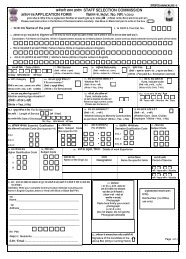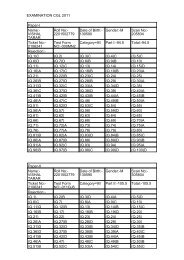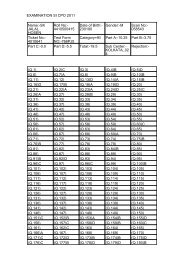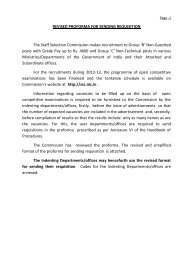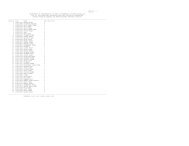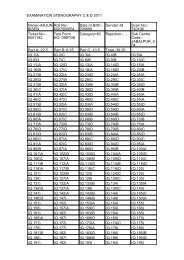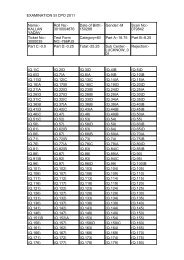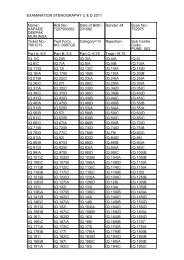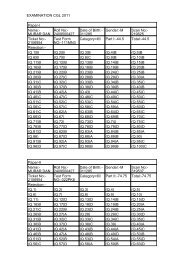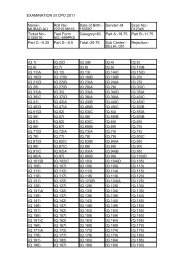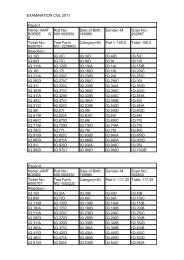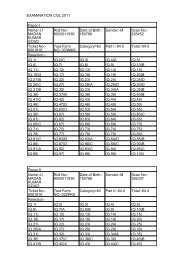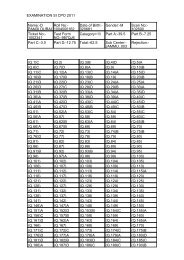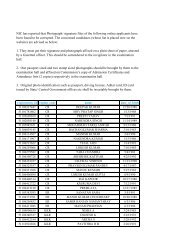STAFF SELECTION COMMISSION NOTICE
STAFF SELECTION COMMISSION NOTICE
STAFF SELECTION COMMISSION NOTICE
Create successful ePaper yourself
Turn your PDF publications into a flip-book with our unique Google optimized e-Paper software.
Measures of Central Tendency- Common measures of central tendency – mean median and mode;<br />
Partition values- quartiles, deciles, percentiles.<br />
Measures of Dispersion- Common measures dispersion – range, quartile deviations, mean deviation and<br />
standard deviation; Measures of relative dispersion.<br />
Moments, Skewness and Kurtosis – Different types of moments and their relationship; meaning of<br />
skewness and kurtosis; different measures of skewness and kurtosis.<br />
Correlation and Regression – Scatter diagram; simple correlation coefficient; simple regression lines;<br />
Spearman‘s rank correlation; Measures of association of attributes; Multiple regression; Multiple and<br />
partial correlation (For three variables only).<br />
Probability Theory – Meaning of probability; Different definitions of probability; Conditional<br />
probability; Compound probability; Independent events; Bayes‘ theorem.<br />
Random Variable and Probability Distributions – Random variable; Probability functions; Expectation<br />
and Variance of a random variable; Higher moments of a random variable; Binomial , Poisson, Normal and<br />
Exponential distributions; Joint distribution of two random variable (discrete).<br />
Sampling Theory – Concept of population and sample; Parameter and statistic, Sampling and nonsampling<br />
errors; Probability and non-probability sampling techniques (simple random sampling, stratified<br />
sampling, multistage sampling, multiphase sampling, cluster sampling, systematic sampling, purposive<br />
sampling, convenience sampling and quota sampling); Sampling distribution (statement only); Sample size<br />
decisions.<br />
Statistical Inference - Point estimation and interval estimation, Properties of a good estimator, Methods<br />
of estimation (Moments method, Maximum likelihood method, Least squares method), Testing of<br />
hypothesis, Basic concept of testing, Small sample and large sample tests, Tests based on Z, t, Chi-square<br />
and F statistic, Confidence intervals.<br />
Analysis of Variance - Analysis of one-way classified data and two-way classified data.<br />
Time Series Analysis - Components of time series, Determinations of trend component by different<br />
methods, Measurement of seasonal variation by different methods.<br />
Index Numbers - Meaning of Index Numbers, Problems in the construction of index numbers, Types of<br />
index number, Different formulae, Base shifting and splicing of index numbers, Cost of living Index<br />
Numbers, Uses of Index Numbers.<br />
NOTE-I: There will not have any component of Map / Graphs / Statistical Data / Diagrams /<br />
Figures / Geometrical problems in Numerical Aptitude in Tier I Examination for Visually<br />
Handicapped candidates of 40% and above visual disability, opting for SCRIBE.<br />
NOTE-II : The Commission shall have the discretion to fix different minimum qualifying standards in<br />
each component of the Tier-I Examination taking into consideration among others, category-wise<br />
vacancies and category-wise number of candidates. Only those candidates, who have scored<br />
above the cut off marks fixed by the Commission would be required to appear in the Tier –II<br />
Examination.<br />
NOTE-III : Tier-I examination will be used to screen the candidates for appearing in Tier-II<br />
examination for various papers which will be specifically required for different groups of posts.<br />
However, marks of such screened candidates in Tier-I will be taken into account for final ranking<br />
of candidates for selecting them for the interview/skill test and also final selection.<br />
NOTE-IV: (i) The Commission will have the full discretion to fix separate minimum qualifying marks<br />
in each of the papers in Tier I or in Tier II and in the aggregate of all the papers separately for<br />
each category of candidates (viz. SC/ST/OBC/PH/ExS/General (UR) ). Only those candidates<br />
who qualify in all the papers as well as in the aggregate would be eligible to be considered<br />
for being called for the Personality Test / Interview and / or Skill Test.<br />
(ii) There will be different set of Questions for the papers on Arithmetic in Tier II for<br />
Visually Handicapped (VH) candidates, which shall not have any component of Map /<br />
16



